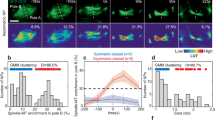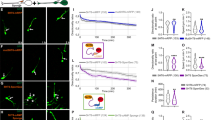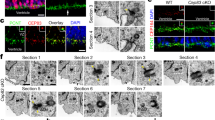Abstract
Neuronal polarization occurs shortly after mitosis. In neurons differentiating in vitro, axon formation follows the segregation of growth-promoting activities to only one of the multiple neurites that form after mitosis1,2. It is unresolved whether such spatial restriction makes use of an intrinsic program, like during C. elegans embryo polarization3, or is extrinsic and cue-mediated, as in migratory cells4. Here we show that in hippocampal neurons in vitro, the axon consistently arises from the neurite that develops first after mitosis. Centrosomes, the Golgi apparatus and endosomes cluster together close to the area where the first neurite will form, which is in turn opposite from the plane of the last mitotic division. We show that the polarized activities of these organelles are necessary and sufficient for neuronal polarization: (1) polarized microtubule polymerization and membrane transport precedes first neurite formation, (2) neurons with more than one centrosome sprout more than one axon and (3) suppression of centrosome-mediated functions precludes polarization. We conclude that asymmetric centrosome-mediated dynamics in the early post-mitotic stage instruct neuronal polarity, implying that pre-mitotic mechanisms with a role in division orientation may in turn participate in this event.
This is a preview of subscription content, access via your institution
Access options
Subscribe to this journal
Receive 51 print issues and online access
$199.00 per year
only $3.90 per issue
Buy this article
- Purchase on Springer Link
- Instant access to full article PDF
Prices may be subject to local taxes which are calculated during checkout




Similar content being viewed by others
References
da Silva, J. S. & Dotti, C. G. Breaking the neuronal sphere: regulation of the actin cytoskeleton in neuritogenesis. Nature Rev. Neurosci. 3, 694–704 (2002)
Horton, A. C. & Ehlers, M. D. Neuronal polarity and trafficking. Neuron 9, 277–295 (2003)
Cowan, C. R. & Hyman, A. A. Centrosomes direct cell polarity independently of microtubule assembly in C. elegans embryos. Nature 431, 92–96 (2004)
Singer, S. J. & Kupfer, A. The directed migration of eukaryotic cells. Annu. Rev. Cell Biol. 2, 337–365 (1986)
Dotti, C. G., Sullivan, C. A. & Banker, G. The establishment of polarity by hippocampal neurons in culture. J. Neurosci. 8, 1454–1468 (1988)
Bradke, F. & Dotti, G. C. The role of actin instability in axon formation. Science 283, 1931–1934 (1999)
Ueda, M., Graf, R., MacWilliams, H. K., Schliwa, M. & Euteneuer, U. Centrosome positioning and directionality of cell movements. Proc. Natl Acad. Sci. USA 94, 9674–9678 (1997)
Grill, S. W., Howard, J., Schaffer, E., Stelzer, E. H. & Hyman, A. A. The distribution of active force generators controls mitotic spindle position. Science 301, 518–521 (2003)
Dotti, C. G. & Banker, G. Intracellular organization of hippocampal neurons during the development of neuronal polarity. J. Cell Sci. 15 (suppl.), 75–84 (1991)
Yonemura, E. M. et al. Rho-dependent transfer of citron-kinase to the cleavage furrow of dividing cells. J. Cell Sci. 114, 3273–3284 (2001)
Wu, C. F., Suzuki, N. & Poo, M. M. Dissociated neurons from normal and mutant Drosophila larval central nervous system in cell culture. J. Neurosci. 3, 1888–1899 (1983)
Megraw, T. L., Kilaru, S., Turner, F. R. & Kaufman, T. C. The centrosome is a dynamic structure that ejects PCM flares. J. Cell Sci. 115, 4707–4718 (2002)
Carney, G. E., Wade, A. A., Sapra, R., Goldstein, E. S. & Bender, M. DHR3, an ecdysone-inducible early-late gene encoding a Drosophila nuclear receptor, is required for embryogenesis. Proc. Natl Acad. Sci. USA 94, 12024–12029 (1997)
Houliston, E. & Maro, B. Post-translational modification of distinct microtubule subpopulations during cell polarization and differentiation in the mouse preimplantation embryo. J. Cell Biol. 108, 543–551 (1989)
Surrey, T. et al. Chromophore-assisted light inactivation and self-organization of microtubules and motors. Proc. Natl Acad. Sci. USA 14, 4293–4298 (1998)
Sydor, A. M., Su, A. L., Wang, F. S., Xu, A. & Jay, D. G. Talin and vinculin play distinct roles in filopodial motility in the neuronal growth cone. J. Cell Biol. 134, 1197–1207 (1996)
Wu, C. F., Sakai, K., Saito, M. & Hotta, Y. Giant Drosophila neurons differentiated from cytokinesis-arrested embryonic neuroblasts. J. Neurobiol. 21, 499–507 (1990)
Craig, A. M. & Banker, G. Neuronal polarity. Annu. Rev. Neurosci. 17, 267–310 (1994)
Yoshimura, T. et al. GSK-3β regulates phosphorylation of CRMP-2 and neuronal polarity. Cell 14, 137–149 (2005)
Shi, S. H., Cheng, T., Jan, L. Y. & Jan, Y. N. APC and GSK-3β are involved in mPar3 targeting to the nascent axon and establishment of neuronal polarity. Curr. Biol. 23, 2025–2032 (2004)
Schwamborn, J. C. & Puschel, A. W. The sequential activity of the GTPases Rap1B and Cdc42 determines neuronal polarity. Nature Neurosci. 7, 923–929 (2004)
Nishimura, T. et al. Role of the PAR-3–KIF3 complex in the establishment of neuronal polarity. Nature Cell Biol. 6, 328–334 (2004)
Shi, S. H., Jan, L. Y. & Jan, Y. N. Hippocampal neuronal polarity specified by spatially localized mPar3/mPar6 and PI 3-kinase activity. Cell 10, 63–75 (2003)
Goslin, K. & Banker, G. Experimental observations on the development of polarity by hippocampal neurons in culture. J. Cell Biol. 108, 1507–1516 (1989)
da Silva, J. S., Hasegawa, T., Miyagi, T., Dotti, C. G. & Abad-Rodríguez, J. Asymmetric membrane ganglioside sialidase activity specifies axonal fate. Nature Neurosci. 8, 606–615 (2005)
Piperno, G. & Fuller, M. T. Monoclonal antibodies specific for an acetylated form of α-tubulin recognize antigens in cilia and flagella from a variety of organisms. J. Cell Biol. 101, 2085–2094 (1985)
De Hoop, M., Meyn, L. & Dotti, C. G. in Methods. in Cell Biology: Laboratory Handbook 2nd edn (ed. Celis, J. E.) 154–163 (Academic Press, San Diego, 1998)
Feiguin, F., Llamazares, S. & Gonzalez, C. Methods in Drosophila cell cycle biology. Curr. Top. Dev. Biol. 36, 279–291 (1998)
Acknowledgements
We would like to thank E. Cassin and B. Hellias for the hippocampal neurons, L. Ciapponi and the Bloomington Stock Center for fly strains, and C. Gonzalez for advice with the neuroblast division experiment. F.C.dA. is supported by an EMBO long-term fellowship. J.S.D.S. was supported by an FCT/PRAXIS XXI scholarship (Portuguese Ministry of Science and Technology). F.F. was supported by an Alexander von Humboldt scholarship. Part of this work is supported by an EU Contract grant (APOPIS) to C.G.D.Author Contributions F.C.d.A. and G.P. were responsible for all in vitro experiments in mammalian and insect neurons, respectively. J.S.D.S. supervised the hippocampal neuron work. P.G.C. helped with the in situ work.
Author information
Authors and Affiliations
Corresponding authors
Ethics declarations
Competing interests
Reprints and permissions information is available at npg.nature.com/reprintsandpermissions. The authors declare no competing financial interests.
Supplementary information
Supplementary Figure S1
The first sprout contains neuronal polarity information. (PDF 229 kb)
Supplementary Figure S2
Organelle polarization marks the site of neuronal polarity. (PDF 496 kb)
Supplementary Figure S3
Drosophila neurons' polarization in vitro and in situ correlates with plane of mitotic division and the localization of the centrosomes. (PDF 592 kb)
Supplementary Figure S4
Centrosomal-mediated polarized microtubule and membrane activities precede morphological polarization in vitro and in situ. (PDF 177 kb)
Supplementary Figure S5
Pharmacological disruption of microtubule polymerization and membrane trafficking prevents morphological polarization. (PDF 99 kb)
Rights and permissions
About this article
Cite this article
de Anda, F., Pollarolo, G., Da Silva, J. et al. Centrosome localization determines neuronal polarity. Nature 436, 704–708 (2005). https://doi.org/10.1038/nature03811
Received:
Accepted:
Issue Date:
DOI: https://doi.org/10.1038/nature03811
This article is cited by
-
Schizophrenia-associated Mitotic Arrest Deficient-1 (MAD1) regulates the polarity of migrating neurons in the developing neocortex
Molecular Psychiatry (2023)
-
RhoGEF Trio Regulates Radial Migration of Projection Neurons via Its Distinct Domains
Neuroscience Bulletin (2022)
-
Parkinson disease-associated mutations in LRRK2 cause centrosomal defects via Rab8a phosphorylation
Molecular Neurodegeneration (2018)
-
Microtubules Modulate F-actin Dynamics during Neuronal Polarization
Scientific Reports (2017)
Comments
By submitting a comment you agree to abide by our Terms and Community Guidelines. If you find something abusive or that does not comply with our terms or guidelines please flag it as inappropriate.



